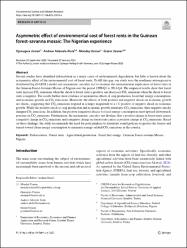Asymmetric effect of environmental cost of forest rents in the Guinean forest-savanna mosaic: The Nigerian experience
Özet
Several studies have identifed deforestation as a major cause of environmental degradation, but little is known about the
asymmetric efect of the environmental cost of forest rents. To fll this gap, our study uses the nonlinear autoregressive
distributed lag (NARDL) model and asymmetric causality test to examine the environmental implication of forest rents in
the Guinean Forest-Savanna Mosaic of Nigeria over the period 1990:Q1 to 2016:Q4. The empirical results show that forest
rents increase CO2 emissions when the shock to forest rents is positive and decreases CO2 emissions when the shock to forest
rents is negative. The results further show evidence of asymmetric efects of crop production, fossil fuel energy consumption,
and economic growth on CO2 emissions. Moreover, the efects of both positive and negative shocks in economic growth
are elastic, suggesting that CO2 emissions respond in a larger magnitude to a 1% positive or negative shock in economic
growth. While the positive shock to crop production and economic growth stimulates CO2 emissions, their negative shocks
dampen CO2 emissions. In addition, the positive (negative) shocks to fossil energy consumption exert upward (downward)
pressure on CO2 emissions. Furthermore, the asymmetric causality test divulges that a positive change in forest rents causes
a negative change in CO2 emissions and a negative change in forest rents causes a positive change in CO2 emissions. Based
on these fndings, the study recommends the need for policymakers to formulate sound policies to protect the forests and
transit toward clean energy consumption to minimize energy-related CO2 emissions in the country.
Bağlantı
https://hdl.handle.net/11363/4308Koleksiyonlar
Aşağıdaki lisans dosyası bu öğe ile ilişkilidir:


















